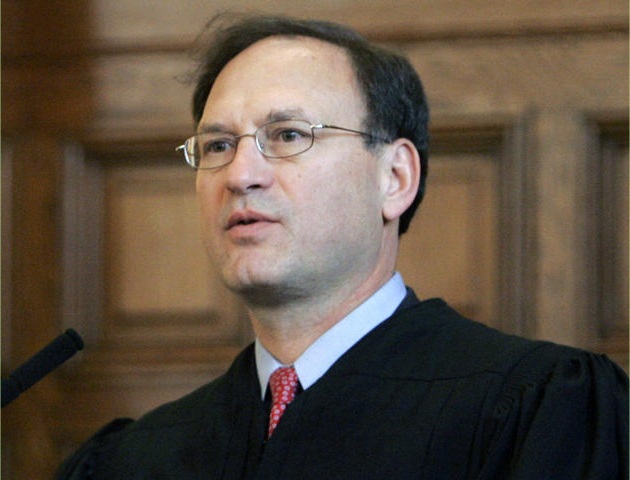The Human Touch Revealing All that is Real
Judicial Activism and the Brown v. Plata Decision of May 23, 2011
A scathing dissent was written by Justice Scalia, with whom Justice Thomas joined. Scalia wrote: "Today the Court affirms what is perhaps the most radical injunction issued by a court in our Nation's history: an order requiring California to release the staggering number of 46,000 convicted criminals. There comes before us, now and then, a case whose proper outcome is so clearly indicated by tradition and common sense, that its decision ought to shape the law, rather than vice versa. One would think that, before allowing the decree of a federal district court to release 46,000 convicted felons, this Court would bend every effort to read the law in such a way as to avoid that outrageous result. Today, quite to the contrary, the Court disregards stringently drawn provisions of the governing statute, and traditional constitutional limitations upon the power of a federal judge, in order to uphold the absurd... I dissent because the institutional reform the District Court has undertaken violates the terms of the governing statute, ignores bedrock limitations on the power of Article III judges, and takes federal courts wildly beyond their institutional capacity." [pg. 59] He further wrote: "It is also worth noting the peculiarity that the vast majority of inmates most generously rewarded by the release order--the 46,000 whose incarceration will be ended-- do not form part of any aggrieved class even under the Court's expansive notion of constitutional violation. Most of them will not be prisoners with medical conditions or severe mental illness; and many will undoubtedly be fine physical specimens who have developed intimidating muscles pumping iron in the prison gym." [pg. 63] What are the deficiencies that caused the majority to conclude that 46,000 prisoners need to be released from prison for Eighth Amendment violations? The deficiencies noted by the majority include the following:
(a) exam tables and counter tops, where prisoners with communicable diseases are treated, are not routinely disinfected;
(b) medical facilities "are in an abysmal state of disrepair";
(c) medications "are too often not available when needed";
(d) basic medical equipment is often not available or used;
(e) sometimes there are long wait times to see a doctor (backlogs);
(f) there is some over-crowding (prisoners may share just a few toilets and showers, which may be "'breeding grounds for disease");
(g) Mentally ill prisoners are housed in administrative segregation;
(h) prisons "would hire any doctor who had "a license, a pulse, and a pair of shoes";
(i) medical and mental health staff positions have high vacancy rates
(k) rooms require repair and/or "prisoner-proofing (for example, two prisoners committed suicide by hanging after being placed in cells that had been identified as requiring a simple fix to remove attachment points that could sup-port a noose)
As Alito asked: "Is it plausible that none of these deficiencies can be remedied without releasing 46,000 prisoners? Without taking that radical and dangerous step, exam tables and counter tops cannot properly be disinfected? None of the system's dilapidated facilities can be repaired? Needed medications and equipment cannot be purchased and used? Staff vacancies cannot be filled? The qualifications of prison physicians cannot be improved? A better records management system cannot be developed and implemented?" [pg. 83]. Clearly, the most of the problems noted above could be addressed without releasing prisoners, putting innocent citizens at risk, and without incurring the costs associated with a large-scale prison construction program. Wouldn't the release of 46,000 prisoners back into California potentially burden health services that are already over-burdened?
 Justice Samuel Alito
Justice Samuel Alito
In his dissent, Scalia expressed great objection to the use of structural injunctions, as the majority supported. As he states, they are not only radically different from the injunctions traditionally issued by courts of equity, but they also exceed the "judicial Power" conferred on federal courts by Article III: "The mandatory injunctions issued upon termination of litigation usually required 'a single simple act.' " As Scalia wrote: "Structural injunctions depart from that historical practice, turning judges into long-term administrators of complex social institutions such as schools, prisons, and police departments. Indeed, they require judges to play a role essentially indistinguishable from the role ordinarily played by executive officials... they force judges to engage in a form of fact-finding-as-policymaking that is outside the traditional judicial role. Today's decision not only affirms the structural injunction but vastly expands its use, by holding that an entire system is unconstitutional because it may produce constitutional violations." [pg. 64]
Scalia also noted that the majority failed to take sufficient notice of the PLRA requirement that, before granting "prospective relief in a civil action with respect to prison conditions," a court "must give substantial weight to any adverse impact on public safety or the operation of a criminal justice system caused by the relief." 18 U. S. C. §3626(a)(1)(A). The majority simply accepted the opinion of the lower court which rejected testimony that inmates released early from prison would commit additional new crimes and instead claimed to find "clear evidence that prison overcrowding would "perpetuate a criminogenic prison system that itself would threaten public safety." The lower court further volunteered its opinion that the prison population should be reduced even further with the reform of California's antiquated sentencing policies. Scalia hinted that the District Judges did not make an objective decision and were bent on the remedy they proposed. As he wrote: "It is impossible for judges to make "factual findings" without inserting their own policy judgments, when the factual findings are policy judgments." And using structural injunctions only encourages judges to insert such policy judgments. [pp. 66-67]
Justice Alito and Chief Justice Roberts agreed with Justices Scalia and Thomas that the lower court abused its discretion by improperly refusing to consider evidence of recidivism and impact to public safety, by refusing to entertain alternative remedies, and by refusing to accept updated information and data about the prison system (including evidence that many of the on-going prison violations had been addressed). For example, rather than prevent the release convicted criminals, the 3-judge panel refused to allow out-of-state transfers for prisoners who volunteered for such relocation. "The three-judge court would have us believe that the early release of 46,000 inmates will not imperil--and will actually improve--public safety. Common sense and experience counsel greater caution," Alito wrote. [pg. 77]. Note that the Court could only reverse the findings of fact of the three-judge court if it held a "'definite and firm conviction that a mistake has been committed (the standard for reversing a lower court's finding of fact), but the conservative justices clearly felt that a mistake in judgment had been made.
The lower court recited statistics that were clearly out of date and the majority perpetuated them, even refusing to receive updated reports. For example, the majority The Court took note that the lower court's finding that as of 2005 "an inmate in one of California's prisons needlessly dies every six to seven days." Yet by the date of the trial before the three-judge district court, the death rate had been trending downward for 10 quarters, and consequently, the number of likely preventable deaths fell from 18 in 2006 to 3 in 2007, a decline of 83 percent. In fact, between 2001-2007, the California prison system had the 13th lowest average mortality rate of all 50 state systems. The fact is that the population of the California prison system, which had 156,000 in-mates at the time of trial, is larger than that of many medium-sized cities, and an examination of the medical care provided to the residents of many such cities would likely reveal cases in which grossly deficient treatment was provided. I think most people can tell tales of family, friends, co-workers, classmates, or even anecdotal tales of people who waited in emergency rooms with serious health problems who we left untreated for far too long. Finally, Scalia noted that the majority's decision encroaches on a matter that traditionally belongs to a state under its sovereignty rights. Essentially, the majority upheld an order granting the functional equivalent of 46,000 writs of habeas corpus. As a result, it "disturbs the State's significant interest in repose for concluded litigation, denies society the right to punish some admitted offenders, and intrudes on state sovereignty to a degree matched by few exercises of federal judicial authority." As he wrote: "It seems that the Court's respect for state sovereignty has vanished in the case where it most matters." (pg. 70)
Summing up his position, Scalia wrote: "I do not believe this Court can affirm this injunction. I will state my approach briefly: In my view, a court may not order a prisoner's release unless it determines that the prisoner is suffering from a violation of his constitutional rights, and that his release, and no other relief, will remedy that violation. Thus, if the court determines that a particular prisoner is being denied constitutionally required medical treatment, and the release of that prisoner (and no other remedy) would enable him to obtain medical treatment, then the court can order his release; but a court may not order the release of prisoners who have suffered no violations of their constitutional rights, merely to make it less likely that that will happen to them in the future. This view follows from the PLRA's text of18 U. S. C. §3626(a)(1)(A): 'Narrowly drawn" means that the relief applies only to the "particular prisoner or prisoners' whose constitutional rights are violated; 'extends no further than necessary' means that prisoners whose rights are not violated will not obtain relief; and 'least intrusive means necessary to correct the violation of the Federal right' means that no other relief is available.... The PLRA is therefore best understood as an attempt to constrain the discretion of courts issuing structural injunctions--not as a mandate for their use. For the reasons I have outlined, structural injunctions, especially prisoner-release orders, raise grave separation-of-powers concerns and veer significantly from the historical role and institutional capability of courts." (pp. 73-74)
Justice Alito, with whom Chief Justice Roberts joined, agreed with Justice Scalia. Alito wrote: " The decree in this case is a perfect example of what the Prison Litigation Reform Act of 1995 (PLRA) was enacted to prevent... In this case, a three-judge court exceeded its authority under the Constitution and the PLRA. " (pg. 75) Before ordering the release of any prisoner, the PLRA commands a court to "give substantial weight to any adverse impact on public safety or the operation of a criminal justice system caused by the relief." §3626(a)(1)(A). This provision unmistakably reflects Congress' acknowledgement that prisoner release is inherently risky. In fact, in creating the PLRA, Congress was well aware of the impact of previous prisoner release orders. The prisoner release program carried out a few years earlier (early 1990's) in Philadelphia provided a good example and should have provided a good example to the Court's majority. The federal courts enforced a cap on the number of inmates in the Philadelphia prison system and as a result, thousands of inmates were set free. Although efforts were made to release only those prisoners who were least likely to commit violent crimes, that attempt was spectacularly unsuccessful. During an18-month period, the Philadelphia police rearrested thousands of these prisoners for committing 9,732 new crimes. Those defendants were charged with 79 murders, 90rapes, 1,113 assaults, 959 robberies, 701 burglaries, and 2,748 thefts, not to mention thousands of drug offenses. Members of Congress were well aware of these statistics. Yet despite these statistics and the records of other past prisoner release orders, the three-judge district court in this case concluded that releasing 46,000 criminals would not result in criminal activity like that seen in Philadelphia and would actually improve public safety. As Alito wrote: " This is a fundamental and dangerous error." (pg. 88). He concluded that the three-judge court approved a population reduction plan that neither it nor the State of California found could assure that its implementation would be without unacceptable harm to public safety.
Scalia concluded that if the only viable constitutional claims consist of individual instances of mistreatment, as in this particular case, then a remedy reforming the system as a whole goes far beyond what the statute (PLRA) allows. (pg. 63) Alito concluded as such. "Here, the majority and the court below maintain that no remedy short of a massive release of prisoners from the general prison population can remedy the State's failure to provide constitutionally adequate health care. This argument is implausible on its face and is not supported by the requisite clear and convincing evidence.... The majority is gambling with the safety of the people of California. Before putting public safety at risk, every reasonable precaution should be taken. The decision below should be reversed, and the case should be remanded for this to be done. I fear that today's decision, like prior prisoner release orders, will lead to a grim roster of victims. I hope that I am wrong. In a few years, we will see." (pp. 82 and 91) I focused on the dissenting opinions because it is nice to hear justices who actually understand the role of Article III courts. I appreciate that while they understand that prisoners have certain rights, they also must not ignore the rights of innocent citizens to be safe and secure in their neighborhoods. I noticed that the Supreme Court justices didn't conduct any "balancing tests" like they did in Roe v. Wade to weigh the legitimate interests of respective parties. Do you think this decision might also be a wake-up call for our government to finally start enforcing a reasonable immigration policy? It is estimated that about 20% of California's prison population is comprised of illegal (Hispanic) immigrants. The court-order upheld by the Supreme Court in this case represents a release back into society of approximately 30% convicted criminals. Without an illegal immigration problem, California would not necessarily have a prison over-crowding problem (that is, one that requires drastic remedies) and the good citizens of the state would not have to face what the people of Philadelphia suffered.
With this brief over-view of activist Supreme Court decisions, I was hoping to show how cavalier our Justices have been over the years with our Constitution and laws to make new law and policy. The Court is currently split equally (4-4) between those who are "originalist" in their approach to interpretation of our Constitution and those who interpret it liberally and often with reckless abandon. One Justice, Justice Kennedy, is often the deciding vote on matters of ideological differences. He is often referred to as the most powerful man in America because whichever side he happens to come down on in any particular case will often be the deciding vote. In McDonald v. City of Chicago, he was the deciding vote on an important Second Amendment rights decision and yet in Plata, he was the deciding vote to open the prisons and send 30% of prisoners back into decent communities. When Obamacare comes before the high Court, Kennedy no doubt will be the Justice to look to.
Understanding judicial activism helps to explain the success of the Progressive Movement. The Progressive Movement seeks to remake society by destroying the old, or traditional, society. It can only do that by destroying the social norms, institutions, and the laws and guidelines we have used to define that traditional. When Progressives can't invalidate laws on their face or through the ordinary government process, it challenges them in federal court, where they know judges aren't necessarily confined by the letter or spirit of the law. OTHER RECENT CASES:
Abbott v. Burke (New Jersey, 2011)
This year, in Abbott v. Burke, the New Jersey state Supreme Court addressed the question of what is the constitutionally-required level of funding for schools. The particular issue before the court was whether the State's failure to fund education at the level called for by the (NJ) School Funding Reform Act of 2008, N.J.S.A. 18A:7F-43 to -63 ("SFRA"), due to budgetary constraints, violated the New Jersey Constitution's guarantee of a "thorough and efficient education."
Up until 2008, when SFRA was enacted, New Jersey had two school systems - 580 conventional districts and 31 "Abbott districts." "Abbott" districts are school districts specifically in New Jersey that are covered by (and named after) a series of NJ Supreme Court rulings, that began in 1985. The 1985 case concluded that the education provided to school children in poor communities was inadequate and thus unconstitutional. The rulings mandated that schools in these districts had to be funded at the level enjoyed by children in the most affluent school districts. That is, the schools in Abbott districts must reach parity with the schools in the wealthier districts. There are 31 "Abbott" school districts in NJ. The purpose of SFRA was to eliminate the distinctions between "Abbott" and "non-Abbott" districts by providing supplemental money to at-risk children no matter where they were enrolled. The SFRA, the law at the center of the controversy, was the brainchild of the Corzine administration. Even though former Governor John Corzine's policies nearly bankrupted the state, Governor Chris Christie was of course obliged to obey the laws he signed, including the SFRA. The problem was that when he signed the state budget, it didn't include enough money to meet the mandates of that law.






















